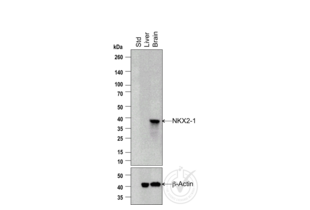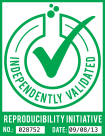TTF1 antibody (AA 201-300)
Quick Overview for TTF1 antibody (AA 201-300) (ABIN728713)
Target
See all TTF1 AntibodiesReactivity
Host
Clonality
Conjugate
Application
-
-
Binding Specificity
- AA 201-300
-
Cross-Reactivity
- Human, Mouse, Rat
-
Purification
- Purified by Protein A.
-
Immunogen
- KLH conjugated synthetic peptide derived from human TTF-1
-
Isotype
- IgG
-
-
-
-
Application Notes
-
WB 1:300-5000
FCM 1:20-100
IHC-P 1:200-400
IHC-F 1:100-500
IF(IHC-P) 1:50-200
IF(IHC-F) 1:50-200
IF(ICC) 1:50-200
ICC 1:100-500 -
Restrictions
- For Research Use only
-
-
- by
- Alamo Laboratories Inc
- No.
- #028752
- Date
- 09/08/2013
- Antigen
- Lot Number
- 120319
- Method validated
- Western Blotting
- Positive Control
- Brain
- Negative Control
- Liver
- Notes
- A strong band was observed at the expected size in the positive control lysate but not in the negative control lysate.
- Primary Antibody
- Antibody: NK2 Homeobox 1 (NKX2-1) antibody
- Catalog number: ABIN728713
- Lot number: 120319
- Secondary Antibody
- Antibody: Goat anti-Rabbit IgG Antibody (HRP)
- Lot number: YYDW62W
- Full Protocol
- 1. Total protein extracts were boiled in 1X SDS Sample Buffer containing 1% SDS and 1.25% Beta-mercaptoethanol at 95°C for 5 minutes prior to loading.
- 2. 24 µg of boiled extracts were loaded and resolved on a 8-16% SDS-polyacrylamide gel.
- 3. The Spectra Multicolor Broad Range molecular mass marker (26634 Thermo Scientific) was used as a standard.
- 4. Proteins were transferred onto PVDF membrane by tank transfer and protein transfer was confirmed with Ponceau S staining.
- 5. The immunoblot membrane was blocked in PBS containing 3% (W/V) non-fat dry milk at room temperature for 1 hour.
- 6. The membrane was rinsed with PBS containing 0.05% Tween-20 once.
- 7. The membrane was immersed with the protein side up in the antibody solution in PBS containing 1% (W/V) non-fat dry milk and incubated for 2 hours at room temperature (~26°C).
- 8. The membrane was rinsed in PBS containing 0.05% Tween-20 thrice for 10 min each.
- 9. The membrane was incubated in the HRP-conjugated secondary antibody solution in PBS containing 1% (W/V) non-fat dry milk and incubated for 1 hour at room temperature (~26°C) with gentle agitation.
- 10. The membrane was rinsed in PBS containing 0.05% Tween-20 thrice for 10 min each.
- 11. The membrane was washed in PBS twice for 30 seconds each.
- 12. Signals were detected with Pierce ECL Western Blotting Substrate (32109, Thermo Scientific). The blot was scanned for 300 seconds.
- 13. The membrane was rinsed three times with PBS containing 0.05% Tween-20.
- 14. Incubated in Acidic Glycine Stripping Buffer at room temperature with gentle agitation for 3 times, 10 min each.
- 15. The membrane was washed in PBS containing 0.05% Tween-20 times for 10 min each.
- 16. Repeated Steps 5-12 with the loading control antibody (for Beta-actin) and its matching secondary antibody.
- Experimental Notes
- None
Validation #028752 (Western Blotting)![Successfully validated 'Independent Validation' Badge]()
![Successfully validated 'Independent Validation' Badge]() Validation Images
Validation Images![Figure 1: Western blot analysis of mouse brain and liver extracts using NK2 Homeobox 1 (NKX2-1) antibody (Catalog number ABIN728713, Lot number 120319). NKX2-1 is present in the positive control sample (brain) and absent from the negative control sample (liver). The arrowhead indicates the expected position of NKX2-1 (predicted MW ~38kDa). 24 micrograms of total protein extracts from each sample were loaded into each lane. Upper panel: scanned image of the NKX2-1 antibody probed with the liver and brain extracts in lanes 2 and 3, respectively. Lower panel: scanned image of the loading control (Beta-actin).]() Figure 1: Western blot analysis of mouse brain and liver extracts using NK2 Homeobox 1 (NKX2-1) antibody (Catalog number ABIN728713, Lot number 120319). NKX2-1 is present in the positive control sample (brain) and absent from the negative control sample (liver). The arrowhead indicates the expected position of NKX2-1 (predicted MW ~38kDa). 24 micrograms of total protein extracts from each sample were loaded into each lane. Upper panel: scanned image of the NKX2-1 antibody probed with the liver and brain extracts in lanes 2 and 3, respectively. Lower panel: scanned image of the loading control (Beta-actin).
Full Methods
Figure 1: Western blot analysis of mouse brain and liver extracts using NK2 Homeobox 1 (NKX2-1) antibody (Catalog number ABIN728713, Lot number 120319). NKX2-1 is present in the positive control sample (brain) and absent from the negative control sample (liver). The arrowhead indicates the expected position of NKX2-1 (predicted MW ~38kDa). 24 micrograms of total protein extracts from each sample were loaded into each lane. Upper panel: scanned image of the NKX2-1 antibody probed with the liver and brain extracts in lanes 2 and 3, respectively. Lower panel: scanned image of the loading control (Beta-actin).
Full Methods -
-
Format
- Liquid
-
Concentration
- 1 μg/μL
-
Buffer
- 0.01M TBS( pH 7.4) with 1 % BSA, 0.02 % Proclin300 and 50 % Glycerol.
-
Preservative
- ProClin
-
Precaution of Use
- This product contains ProClin: a POISONOUS AND HAZARDOUS SUBSTANCE, which should be handled by trained staff only.
-
Storage
- 4 °C,-20 °C
-
Storage Comment
- Shipped at 4°C. Store at -20°C for one year. Avoid repeated freeze/thaw cycles.
-
Expiry Date
- 12 months
-
-
-
: "Second and third trimester amniotic fluid mesenchymal stem cells can repopulate a de-cellularized lung scaffold and express lung markers." in: Journal of pediatric surgery, Vol. 49, Issue 11, pp. 1554-63, (2014) (PubMed).
: "Upregulation of thyroid transcription factor-1 and human leukocyte antigen class I in Hashimoto's disease providing a clinical evidence for possible triggering autoimmune reaction." in: European journal of endocrinology / European Federation of Endocrine Societies, Vol. 164, Issue 5, pp. 795-800, (2011) (PubMed).
-
: "Second and third trimester amniotic fluid mesenchymal stem cells can repopulate a de-cellularized lung scaffold and express lung markers." in: Journal of pediatric surgery, Vol. 49, Issue 11, pp. 1554-63, (2014) (PubMed).
-
- TTF1 (Transcription Termination Factor, RNA Polymerase I (TTF1))
-
Alternative Name
- TTF1
-
Background
-
Synonyms: BCH, BHC, NK-2, TEBP, TTF1, NKX2A, T/EBP, TITF1, TTF-1, NKX2.1, Homeobox protein Nkx-2.1, Homeobox protein NK-2 homolog A, Thyroid nuclear factor 1, Thyroid transcription factor 1, Thyroid-specific enhancer-binding protein, NKX2-1
Background: Transcription factor that binds and activates the promoter of thyroid specific genes such as thyroglobulin, thyroperoxidase, and thyrotropin receptor. Crucial in the maintenance of the thyroid differentiation phenotype. May play a role in lung development and surfactant homeostasis. Activates the transcription of GNRHR and plays a role in enhancing the circadian oscillation of its gene expression. Represses the transcription of the circadian transcriptional repressor NR1D1 (By similarity).
-
Gene ID
- 7080
-
UniProt
- P43699
-
Pathways
- Thyroid Hormone Synthesis, Regulation of Systemic Arterial Blood Pressure by Hormones, Feeding Behaviour
Target
-


 (2 references)
(2 references) (1 validation)
(1 validation)



